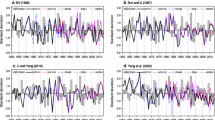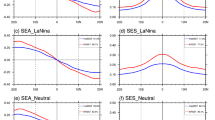Abstract
The predictability and variability of extratropical climate are largely associated with tropical forcing through various teleconnections. The East Asia–Pacific/Pacific-Japan (EAP/PJ) teleconnection is one of the most important factors affecting the summer climate in East Asia. In this work, we confirm the weakening relationship between the El Niño-Southern Oscillation (ENSO) and the following summer PJ teleconnection after the late 1990s and diagnose the possible causes. The results show that compared with that of in 1981–1998, ENSO is less conducive to the formation of anomalous anticyclones in the following summer in the Northwest Pacific (NWP) and the northward propagating Rossby wave train from latitudes of NWP in 2000–2017, resulting in a weaker summer PJ teleconnection. Meanwhile, variation of ENSO feature since 2000 with a suppressed variability leads to a weakened response in the tropical Indian Ocean in the spring and summer. The reduced sea surface temperature response in the tropical Indian Ocean suppresses the excitation of eastward-propagating Kelvin waves and declines the capacitor effect of the Indian Ocean, which is unfavorable for generating anomalies in the NWP and motivating strong PJ teleconnection in meridional direction. Thus, the weakening relationship of ENSO-PJ after late 1990s is the result of the weakened ENSO’s impact on the formation of anticyclones in the following summer in NWP and the declined Indian Ocean capacitor effect on motivating meridionals wave train over East Asia and NWP region.














Similar content being viewed by others
Data availability
The datasets generated during and/or analyzed during the current study are available from the corresponding author on reasonable request.
References
Bader J, Latif M (2005) North Atlantic Oscillation response to anomalous Indian Ocean SST in a coupled GCM. J Clim 18:5382–5389
Chen SF, Chen W, Yu B, Graf HF (2013) Modulation of the seasonal footprinting mechanism by the boreal spring Arctic Oscillation. Geophys Res Lett 40:6384–6389
Chen W, Hong X, Lu R, Jin A, Jin S, Nam J-C, Shin J-H, Goo T-Y, Kim B-J (2016) Variation in summer surface air temperature over Northeast Asia and its associated circulation anomalies. Adv Atmos Sci 33:1–9
Choi KS, Wu CC, Cha EJ (2010) Change of tropical cyclone activity by Pacific-Japan teleconnection pattern in the western North Pacific. J Geophys Res Atmos 115:1–13
Duan W, Mu M, Wang B (2004) Conditional nonlinear optimal perturbations as the optimal precursors for El Nino-Southern Oscillation events. J Geophys Res Atmos 109:1–12
Gong ZQ, Dogar M, Qiao SB, Po Hu, Feng GL (2017) Limitations of BCC_CSM’s ability to predict summer precipitation over East Asia and the Northwestern Pacific. Atmos Res 193:184–191
Gong ZQ, Feng GL, Dogar M, Huang G (2018) The possible physical mechanism for the EAP-SR co-action. Clim Dyn 51:1499–1516
Hong CC, Chang TC, Hsu HH (2014a) Enhanced relationship between the tropical Atlantic SST and the summertime western North Pacific subtropical high after the early 1980s. J Geophys Res Atmos 119:3715–3722
Hong CC, Chang TC, Hsu HH (2014b) Enhanced relationship between the tropical Atlantic SST and the summertime western North Pacific subtropical high after the early 1980s. J Geophys Res Atmos 119(7):3715–3722
Hu ZZ, Kumar A, Ren HL, Wang H, L’Heureux M, Jin FF (2013) Weakened interannual variability in the tropical Pacific Ocean since 2000. J Clim 26:2601–2613
Hu ZZ, Kumar A, Huang B (2016) Spatial distribution and the interdecadal change of leading modes of heat budget of the mixed-layer in the tropical Pacific and the association with ENSO. Clim Dyn 46:1753–1768
Hu ZZ, Kumar A, Huang B, Zhu J, L’Heureux M, McPhaden MJ, Yu JY (2020) The interdecadal shift of ENSO properties in 1999/2000: a review. J Clim 33:4441–4462
Huang G (2004) An Index measuring the interannual variation of the east Asian summer monsoon—the EAP index. Adv Atmos Sci 21:41–52
Huang R, Sun F (1992) Impacts of the tropical western Pacific on the East Asian summer monsoon. J Meteorol Soc Jpn 70:243–256
Huang R, Wu Y (1989) The influence of ENSO on the summer climate change in China and its mechanism. Adv Atmos Sci 6:21–32
Huang G, Hu KM, Xie SP (2010) Strengthening of tropical Indian Ocean teleconnection to the northwest Pacific since the mid-1970s: an atmospheric GCM study. J Clim 23:5294–5304
Huang R, Liu Y, Feng T (2012) Interdecadal change of summer precipitation over Eastern China around the late-1990s and associated circulation anomalies, internal dynamical causes. Chin Sci Bull 58:1339–1349
Huang BY, Thorne PW et al (2017) Extended reconstructed sea surface temperature, version 5 (ERSSTv5): upgrades, validations, and intercomparisons. J Clim 30:8179–8205
Huang R (1987) Influence of the heat source anomaly over the tropical western Pacific on the subtropical high over East Asia. In: International conference on the general circulation of East Asia, Chengdu, pp 40–51
Jin D, Hameed SN, Huo L (2016) Recent changes in ENSO teleconnection over the western Pacific impacts the eastern China precipitation dipole. J Clim 29:7587–7598
Kalnay E, Kanamitsu M et al (1996) The NCEP/NCAR 40-year reanalysis project. Bull Am Meteorol Soc 77:437–472
Kosaka Y, Nakamura H (2006) Structure and dynamics of the summertime Pacific-Japan teleconnection pattern. Q J R Meteorol Soc 132:2009–2030
Kosaka Y, Chowdary JS, Xie S, Min Y, Lee J (2012) Limitations of seasonal predictability for summer climate over east Asia and the northwestern Pacific. J Clim 25:7574–7589
Kubota H, Kosaka Y, Xie SP (2016) A 117-year long index of the Pacific-Japan pattern with application to interdecadal variability. Int J Climatol 36:1575–1589
Kug JS, Kang IS (2006) Interactive feedback between ENSO and the Indian ocean. J Clim 19:1874–1801
Li J, Chou J (2003) Global analysis theory of climate system and its applications. Chin Sci Bull 48:1034–1039
Li X, Lu R (2020) Breakdown of the summertime meridional teleconnection pattern over the western North Pacific and East Asia since the early 2000s. J Clim 33:8487–8505
Li H, Dai A, Zhou T, Lu J (2008) Responses of East Asian summer monsoon to historical SST and atmospheric forcing during 1950–2000. Clim Dyn 34:501–514
Li X, Hu ZZ, Becker E (2019) On the westward shift of tropical Pacific climate variability since 2000. Clim Dyn 53:2905–2918
Lu RY (2001) Atmospheric circulations and sea surface temperatures related to the convection over the western Pacific warm pool on the interannual scale. Adv Atmos Sci 18:270–282
Lu RY, Lin ZD (2009) Role of subtropical precipitation anomalies in maintaining the summertime meridional teleconnection over the western North Pacific and East Asia. J Clim 22:2058–2072
Lu R, Li Y, Dong B (2006) External and internal summer atmospheric variability in the western North Pacific and East Asia. J Meteorol Soc Jpn 84:447–462
McPhaden M (2012) A 21st century shift in the relationship between ENSO SST and warm water volume anomalies. Geophys Res Lett 39:1–5
McPhaden M, Luebbecke J (2014) Assessing the 21st century shift in ENSO variability in terms of the Bjerknes stability index. J Clim 27:2577–2587
Nitta T (1987) Convective activities in the tropical western Pacific and their impact on the northern hemisphere summer circulation. J Meteorol Soc Jpn 65:373–390
Nitta T, Hu Z (1996) Summer climate variability in China and its association with. J Meteorol Soc Jpn 74:425–445
Ren HL, Jin FF (2011) Nino indices for two types of ENSO. Geophys Res Lett 38:L04704
Sardeshmukh PD, Hoskins BJ (1988) The generation of global rotational flow by steady idealized tropical divergence. J Atmos Sci 45:1228–1251
Sun L, Yang XQ, Tao L, Fang J, Sun X (2021) Changing impact of ENSO events on the following summer rainfall in eastern China since the 1950s. J Clim 34:8105–8123
Wang B (1995) Interdecadal changes in El Nino onset in the last four decades. J Clim 8:267–285
Wang B, Zhang Q (2002) Pacific–east Asian teleconnection. Part II: how the Philippine Sea anomalous anticyclone is established during El Nino development. J Clim 15:3252–3265
Wang L, Chen W, Huang RH (2007) Changes in the variability of North Pacific Oscillation around 1975/76 and its relationship with East Asian winter climate. J Geophys Res Atmos 112:D11110
Wang L, Yu JY, Paek H (2017) Enhanced biennial variability in the Pacific due to Atlantic capacitor effect. Nat Commun 8(1):1–7
Wang Z, Wen Z, Chen R, Li X, Huang S (2020) Interdecadal enhancement in the interannual variability of the summer monsoon meridional circulation over the South China Sea around the early 1990s. Clim Dyn 55:2149–2164
Wu Z, Wang B, Li J, Jin FF (2009) An empirical seasonal prediction model of the East Asian summer monsoon using ENSO and NAO. J Geophys Res Atmos. https://doi.org/10.1029/2009JD011733
Xiang B, Wang B, Li T (2013) A new paradigm for the predominance of standing central Pacific warming after the late 1990s. Clim Dyn 41:327–340
Xie S, Hu K, Hafner J, Tokinaga H, Du Y, Huang G, Sampe T (2009) Indian Ocean capacitor effect on Indo-western Pacific climate during the summer following El Niño. J Clim 22:730–747
Xu P, Wang L, Chen W, Feng J, Liu Y (2019) Structural changes in the Pacific-Japan pattern in the late 1990s. J Clim 32:607–621
Yeh SW, Kug JS, Dewitte B, Kwon MH, Kirtman BP, Jin FF (2009) El Niño in a changing climate. Nature 461:511–514
Acknowledgements
This work was supported by the National Key Research and Development Program of China (2018YFA0606301), the National Natural Science Foundation of China Project (42130610, 42075057 and 42275050).
Funding
Key Programme, 42130610, Guolin Feng.
Author information
Authors and Affiliations
Corresponding authors
Ethics declarations
Conflict of interest
The authors declare no conflict of interest. Authors have no additional information that might be relevant for the editors, reviewers and readers. The funding sponsors have no participation in the execution of the experiment, the decision to publish the results, nor the writing of the manuscript.
Additional information
Publisher's Note
Springer Nature remains neutral with regard to jurisdictional claims in published maps and institutional affiliations.
Rights and permissions
Springer Nature or its licensor (e.g. a society or other partner) holds exclusive rights to this article under a publishing agreement with the author(s) or other rightsholder(s); author self-archiving of the accepted manuscript version of this article is solely governed by the terms of such publishing agreement and applicable law.
About this article
Cite this article
Wang, X., Hu, ZZ., Hu, P. et al. The weakening relationship between ENSO and the following summer Pacific Japan teleconnection since the late 1990s. Clim Dyn 61, 4033–4046 (2023). https://doi.org/10.1007/s00382-023-06783-x
Received:
Accepted:
Published:
Issue Date:
DOI: https://doi.org/10.1007/s00382-023-06783-x




